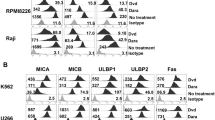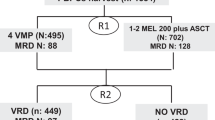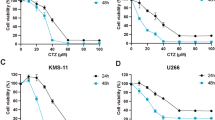Abstract
Aim:
To investigate the effects of lidamycin (LDM) on a mouse myeloma cell line (SP2/0) and human multiple myeloma cell lines (U266 and SKO-007), and provide the basis for the use of LDM in cancer therapy.
Methods:
A 3-[4,5-dimethylthiazol-2-yl]5-[3-carboxymethoxyphenyl]-2-[4-sulfophenyl]2H-tetrazolium inner salt (MTS) assay was used to determine the degree of growth inhibition by the drugs analyzed in this study. Cell cycle distribution and analysis were measured by flow cytometry combined with propidium iodide (PI) staining. The effects on apoptosis were measured by Hoechst 33342 staining and by flow cytometry combined with fluorescein-isothiocyanate-Annexin V/propidium iodide (FITC-Annexin V/PI) staining. Protein expression was determined by Western blot analysis. In vivo antitumor activity was measured using a murine myeloma model in BALB/c mice.
Results:
There was a significant reduction in cell proliferation after treatment with LDM. The overall growth inhibition correlated with increased apoptotic cell death. LDM-induced cell apoptosis was associated with the activation of c-Jun-N-terminal kinase (JNK), and cleavage of caspase-3/7 and poly (ADP-ribose) polymerase (PARP). LDM markedly suppressed tumor growth in a murine myeloma model.
Conclusion:
LDM induces apoptosis in murine myeloma SP2/0 cells as well as in human myeloma U266 and SKO-007 cell lines. The sustained activation of JNK might play a critical role in LDM-induced apoptosis in the SP2/0 cell line. LDM demonstrates significant antitumor efficacy against myeloma SP2/0 cells in mice. Taken together, our data provide some clues for further research of the effects of LDM on human multiple myeloma.
Similar content being viewed by others
Log in or create a free account to read this content
Gain free access to this article, as well as selected content from this journal and more on nature.com
or
References
Gregory WM, Richards MA, Malpas JS . Combination chemotherapy versus melphalan and prednisolone in the treatment of multiple myeloma: an overview of published trials. J Clin Oncol 1992; 10: 334–42.
Chiusolo P, Sica S, Piccirillo N, Giordano G, Laurenti L, La Barbera EO, et al. Molecular and clinical follow-up after stem cell transplantation for multiple myeloma. Ann Hematol 2001; 80: 90–5.
Iguchi T, Yachide-Noguchi T, Hashimoto Y, Nakazato S, Sagawa M, Ikeda Y, et al. Novel tubulin-polymerization inhibitor derived from thalidomide directly induces apoptosis in human multiple myeloma cells: possible anti-myeloma mechanism of thalidomide. Int J Mol Med 2008; 21: 163–8.
Chauhan D, Hideshima T, Anderson KC . Targeting proteasomes as therapy in multiple myeloma. Adv Exp Med Biol 2008; 615: 251–60.
Pineda-Roman M, Zangari M, van Rhee F, Anaissie E, Szymonifka J, Hoering A, et al. VTD combination therapy with bortezomib- thalidomide-dexamethasone is highly effective in advanced and refractory multiple myeloma. Leukemia 2008; 22: 1419–27.
Potter M, Fahey JL . Studies on eight transplantable plasma-cell neoplasms of mice. J Natl Cancer Inst 1960; 24: 1153–65.
Foster LJ, Catzel D, Atwa S, Zarka M, Mahler SM . Increase in synthesis of human monoclonal antibodies by transfected Sp2/0 myeloma mouse cell line under conditions of microgravity. Biotechnol Lett 2003; 25: 1271–4.
Hu JL, Xue YC, Xie MY, Zhang R, Otani T, Minami Y, et al. A new macromolecular antitumor antibiotic, C-1027. I. Discovery, taxonomy of producing organism, fermentation and biological activity. J Antibiot 1988; 41: 1575–9.
Xu YJ, Zhen YS, Goldberg IH . C1027 chromophore, a potent new enediyne antitumor antibiotic, induces sequencespecific double-strand DNA cleavage. Biochemistry 1994; 33: 5947–54.
Huang YH, Shang BY, Zhen YS . Antitumor efficacy of lidamycin on hepatoma and active moiety of its molecule. World J Gastroenterol 2005; 11: 3980–4.
Chen J, Ouyang ZG, Zhang SH, Zhen YS . Down-regulation of the nuclear factor-kappaB by lidamycin in association with inducing apoptosis in human pancreatic cancer cells and inhibiting xenograft growth. Oncol Rep 2007; 17: 1445–51.
Tanaka T, Fukuda-Ishisaka S, Hirama M, Otani T . Solution structures of C-1027 apoprotein and its complex with the aromatized chromophore. J Mol Biol 2001; 309: 267–83.
Shao RG, Zhen YS . Relationship between the molecular composition of C1027, a new macromolecular antibiotic with enediyne chromophore, and its antitumor activity. Acta Pharm Sin 1995; 30: 336–42.
He QY, Liang YY, Wang DS, Li DD . Characteristics of mitotic cell death induced by enediyne antibiotic lidamycin in human epithelial tumor cells. Int J Oncol 2002; 20: 261–6.
Chen J, Wu SY, Ou-Yang ZG, Zhen YS . Synergy of gemcitabine and lidamycin associated with NF-kappaB downregulation in pancreatic carcinoma cells. Acta Pharmacol Sin 2008; 29: 614–9.
Kennedy DR, Beerman TA . The radiomimetic enediyne C-1027 induces unusual DNA damage responses to double-strand breaks. Biochemistry 2006; 45: 3747–54.
Liu X, Bian C, Ren K, Jin H, Li B, Shao RG . Lidamycin induces marked G2 cell cycle arrest in human colon carcinoma HT-29 cells through activation of p38 MAPK pathway. Oncol Rep 2007; 17: 597–603.
McHugh MM, Gawron LS, Matsui S, Beerman TA . The antitumor enediyne C-1027 alters cell cycle progression and induces chromosomal aberrations and telomere dysfunction. Cancer Res 2005; 65: 5344–51.
Iwamoto T, Hiraku Y, Kojima M, Kawanishi S . Amplification of C1027-induced DNA cleavage and apoptosis by a quinacrine-netropsin hybrid molecule in tumor cell lines. Arch Biochem Biophys 2005; 434: 232–40.
Hideshima T, Mitsiades C, Akiyama M, Hayashi T, Chauhan D, Richardson P, et al. Molecular mechanisms mediating antimyeloma activity of proteasome inhibitor PS-341. Blood 2003; 101: 1530–4.
Hideshima T, Catley L, Yasui H, Ishitsuka K, Raje N, Mitsiades C, et al. Perifosine, an oral bioactive novel alkylphospholipid, inhibits Akt and induces in vitro and in vivo cytotoxicity in human multiple myeloma cells. Blood 2006; 107: 4053–62.
Hideshima T, Chauhan D, Hayashi T, Podar K, Akiyama M, Mitsiades C, et al. Antitumor activity of lysophosphatidic acid acyltransferase-β inhibitors, a novel class of agents, in multiple myeloma. Cancer Res 2003; 63: 8428–36.
Rahmani M, Reese E, Dai Y, Bauer C, Payne SG, Dent P, et al. Coadministration of histone deacetylase inhibitors and perifosine synergistically induces apoptosis in human leukemia cells through Akt and ERK1/2 inactivation and the generation of ceramide and reactive oxygen species. Cancer Res 2005; 65: 2422–32.
Kajiguchi T, Yamamoto K, Iida S, Ueda R, Emi N, Naoe T . Sustained activation of c-jun-N-terminal kinase plays a critical role in arsenic trioxide-induced cell apoptosis in multiple myeloma cell lines. Cancer Sci 2006; 97: 540–5.
Shtil AA, Mandlekar S, Yu R, Walter RJ, Hagen K, Tan TH, et al. Differential regulation of mitogen-activated protein kinases by microtubule-binding agents in human breast cancer cells. Oncogene 1999; 18: 377–84.
Kyriakis JM, Avruch J . Mammalianmitogen-activated protein kinase signal transduction pathways activated by stress and inflammation. Physiol Rev 2001; 81: 807–69.
Wang TH, Wang HS, Ichijo H, Giannakakou P, Foster JS, Fojo T, et al. Microtubule-interfering agents activate c-Jun N-terminal kinase/stress-activated protein kinase through both Ras and apoptosis signal-regulating kinase pathway. J Biol Chem 1998; 273: 4928–36.
Stone AA, Chambers TC . Microtubule inhibitors elicit differential effects on MAP kinase (JNK, ERK, and p38) signaling pathways in human KB-3 carcinoma cells. Exp Cell Res 2000; 254: 110–9.
Caers J, Menu E, De Raeve H, Lepage D, Van Valckenborgh E, Van Camp B, et al. Antitumour and antiangiogenic effects of Aplidin in the 5TMM syngeneic models of multiple myeloma. Br J Cancer 2008; 98: 1966–74.
Dou J, Chu L, Zhao F, Tang Q, Zhang A, Zhang L, et al. Study of immunotherapy of murine myeloma by an IL-21-based tumor vaccine in BALB/C mice. Cancer Biol Ther 2007; 6: 1871–9.
Acknowledgements
This study was supported by the National High Technology Research and Development 863 Program of China (No 2004AA2Z3950) and the Key Basic Research Development 973 Program Foundation of China (No 2004CB518706).
Author information
Authors and Affiliations
Corresponding author
Rights and permissions
About this article
Cite this article
Zhen, Yz., Lin, Yj., Li, Y. et al. Lidamycin shows highly potent cytotoxic to myeloma cells and inhibits tumor growth in mice. Acta Pharmacol Sin 30, 1025–1032 (2009). https://doi.org/10.1038/aps.2009.75
Received:
Accepted:
Published:
Issue date:
DOI: https://doi.org/10.1038/aps.2009.75
Keywords
This article is cited by
-
Chloroquine potentiates the anti-cancer effect of lidamycin on non-small cell lung cancer cells in vitro
Acta Pharmacologica Sinica (2014)
-
Antitumor effects of an engineered and energized fusion protein consisting of an anti-CD20 scFv fragment and lidamycin
Science China Life Sciences (2011)



